
Common name:Elija Blue Fescue
Botanical name:Festuca glauca 'Elija Blue'
The 'Elijah Blue' is a dwarf variety with gray blue (but sometimes white-looking) foliage. It should receive sun and little summer watering.
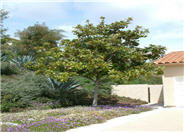
Common name:Southern Magnolia, Bull Bay
Botanical name:Magnolia grandiflora
Its large, simple, leathery appearance makes the pyramidal Magnolia grandiflora perfect for either a street or lawn tree. Its leaves are 4"-8" long, and its powerfully fragrant blooms are carried throughout the summer and fall. If these plants are grafted, they are more predictable (may take 15 years to bloom). Ungrafted trees will take only 2-3 years. Restricted root areas or heavy soils will slow the growth process.
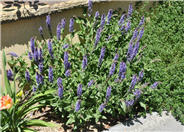
Common name:Mealy Cup Blue Sage
Botanical name:Salvia farinacea
This low growing perennial reach 1-1/2' x 1-1/2'. Bright green leaves are lighter underneath. Spiked blue-purple flowers bloom from late spring to fall. Attracts hummingbirds.

Common name:Rock Purslane
Botanical name:Cistanthe grandiflora 'Jazz Time'
This perennial will grow 12"-36" and produces large blue-green rosettes that last for a long season. It produces large, silky, lavender pink flowers that have lime-green, purple spotted calyces.
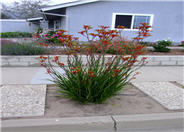
Common name:Red Cross Kangaroo Paws
Botanical name:Anigozanthos 'Red Cross'
Red Cross Kangaroo Paws has showy, tall (4'-5'), multi- branched stems with rich red color on both flowers and stems. The flowers have a green interior. It is fast growing.
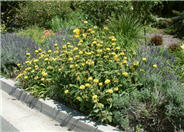
Common name:Jerusalem Sage
Botanical name:Phlomis fruticosa
This hardy perennial is a useful, old-time garden plant with coarse, woolly gray green, wrinkled leaves and yellow, 1" flowers in ball-shaped whorls. It handles drought and poor soils but needs full sun.
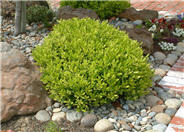
Common name:Wheeler's Dwarf Pittosporum
Botanical name:Pittosporum tobira 'Wheeler's Dwarf'
This handsome dwarf form of the Pittosporum tobira grows into a low, dense mound that is covered with glossy, evergreen foliage.
| Designer: The Plant Nerd | Planting Island and Trains |
Photographer: GardenSoft |
Soils and Compost:
Incorporate compost 6" into your soil to retain water, reduce compaction, feed earthworms, and provide valuable nutrients to your plants.
Water Saving Tip:
Irrigate in the early morning to minimize evaporation.
Integrated Pest Management:
Drip and other smart irrigation delivers water directly to roots, allowing no excess water for weeds.

